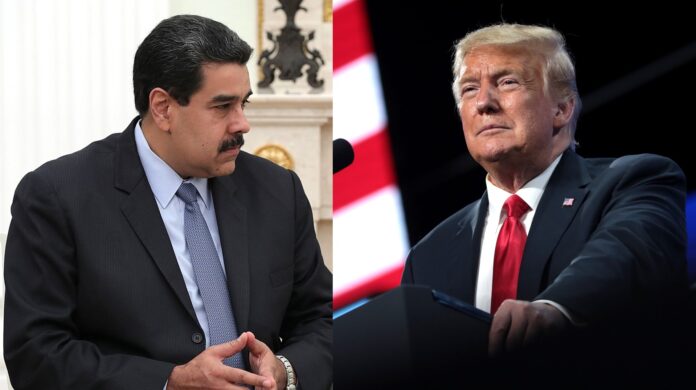
Venezuela’s President Nicolas Maduro has publicly embraced the prospect of guerrilla warfare as a fallback option to repel a possible United States invasion, calling for a people’s resistance modeled on the tactics of Ho Chi Minh as tensions mounted this week after the arrival of the U.S. carrier Gerald R. Ford near the Caribbean.
Guerrilla warfare is a war tactic composed of small, mobile units carrying out sabotage, ambushes, and prolonged resistance to wear down a conventionally superior force. It is being presented by Maduro’s government as a way to compensate for its conventional weaknesses.
Officials have invoked lessons from Vietnam’s long resistance to the United States, emphasizing “war of the people” principles that place political mobilization and local support above conventional firepower.
“If imperialism were to strike, the Venezuelan working class would declare an insurrectionary general strike,” Maduro said at a recent ruling-party event, urging militias and civilians to prepare to “defend the homeland.” The government has said it is studying Ho Chi Minh’s strategy of protracted warfare and is expanding training for militias and other armed supporters.
Analysts say Maduro’s potential use of guerrilla warfare tactics in Venezuela reflects the poor state of the country’s armed forces
The move follows a stepped-up U.S. military presence in the region, including the Gerald R. Ford carrier and a flotilla of warships, a nuclear submarine, and F-35 jets, part of what Washington says are operations to disrupt narcotics trafficking. The U.S. campaign has included strikes on vessels in Caribbean waters that Venezuelan authorities and others say have killed scores of people, a development Caracas has cited in warnings about possible escalation.
But analysts say the guerrilla fallback reflects hard realities inside the country’s armed forces, which include low morale, poor pay, and dwindling equipment. Rank-and-file soldiers earn roughly US$100 a month in local currency, far short of the estimated US$500 monthly cost of a basic food basket, according to Reuters reporting, and there have been repeated reports of desertions and commanders forced to negotiate with local producers to feed troops. “We wouldn’t last two hours in a conventional war,” one government-linked source told Reuters.
Those conditions have driven the regime to rely on an expanded web of irregular forces, from the formal National Militia to “colectivos,” armed civilian groups that back the ruling party, and to prepare plans for distributed resistance.
Reuters and other reporting say military planners have considered sending small units to more than 280 locations across the country to wage “prolonged resistance,” and older planning documents reviewed by reporters detail guerrilla tactics and the use of simple navigation tools and light weapons in such a scenario.
Venezuela’s dated arsenal poses yet another constraint for the regime
Yet Venezuela’s arsenal and logistics pose additional constraints. Much of the military hardware is Russian-made and aging, maintenance is poor, and key systems from Sukhoi jets bought in the 2000s to helicopters, tanks, and shoulder-fired anti-aircraft missiles are described by sources as outdated and in need of repair.
Venezuela has deployed some 5,000 Igla portable surface-to-air missiles, President Maduro has said on state television, but sources warn that the overall force is ill-maintained and outmatched by U.S. military capabilities. Defense analysts say Caracas has sought assistance from allies, requesting radar upgrades, aircraft repairs, and potentially missiles from Russia, China, and Iran; Moscow has said it is prepared to respond to requests.
Beyond preparing militias and moving forces to “full operational readiness” under a doctrine dubbed Plan Independencia 200, the government has also repurposed civic tools and layered security measures.
Officials have adapted a municipal utility app into a reporting platform for citizens to flag “suspicious behavior,” and Interior Minister Diosdado Cabello has been pictured in rural areas encouraging the use of machetes and local organization to bolster defenses. The ruling United Socialist Party of Venezuela has even discussed a move to a “phase armed” posture should hostilities erupt.
Members of the armed forces have also discussed a complementary concept known as “anarchization,” in which intelligence services and pro-government armed supporters would foment disorder, complicating governance and the operations of any invading force. Analysts say the idea, and the broader emphasis on deterrence through chaos, aims in part to send a political message of risk to potential adversaries.
Despite having a force of close to 340,000 troops, reports suggest only 60,000 may be ready to deploy as a guerrilla
Still, multiple sources inside and outside government caution that a guerrilla strategy faces steep odds. Planners in Venezuela estimate the country’s armed forces at roughly 340,000 personnel overall, but reporting suggests only some 60,000 might be available to deploy in sustained guerrilla warfare operations alongside militia forces.
Maduro has claimed that millions of civilians are being trained in militias, but independent observers and opposition sources say actual participation and effectiveness could be far lower.
The government’s own internal assessments, reflected in planning documents and interviews cited by Reuters, underline the limits. Some of them include poor training, frayed logistics, and years of underfunding have hollowed out Venezuela’s conventional capabilities.
“The underlying message isn’t actual military capability but deterrence through chaos,” defense analyst Andrei Serbin Pont said, warning that weapons and fractured loyalties could hand armed groups and paramilitaries new means to foment violence during any transition.
For now, Caracas appears to be attempting a two-pronged approach, preparing irregular defenses while publicly projecting unity and resolve. Defense Minister Vladimir Padrino Lopez ordered a short-term “complete operational readiness” this week, deploying land, air, riverine, and missile assets alongside the militia and security services, and state media have shown military displays and exercises.
See all the latest news from Colombia and the world at ColombiaOne.com. Contact our newsroom to report an update or send your story, photos and videos. Follow Colombia One on Google News, Facebook, Instagram, TikTok and subscribe here to our newsletter.


